History
The George Peabody Library was funded by George Peabody (1795–1869). Peabody, having become a wealthy man in Baltimore through commerce during the 1810s and 1820s, following his brief service in the state militia defending the city against the famous British attack during the War of 1812, "gave $300,000 as a beginning sum for the Peabody Institute" in February 1857. [3] The institute was originally planned to open in 1860, but border-state conflict in the region caused by the American Civil War delayed its establishing and construction until 1866. The first George Peabody Library librarian, John Morris, and the Library Committee, chaired by George Pendleton Kennedy, used this time to study and catalogue the collections of the greatest libraries in the U.S. and Europe. Morris then created a list of 50,000 books, and actively pursued their retrieval regardless of difficulty or expense. This practice was a great success, and was continued by the next librarian, Nathaniel Holmes Morrison. As Morrison's assistant, the scientist Philip Reese Uhler would expand this practice to scientific texts by seeking out experts in several scientific fields for advice. This form of collection development has become a standard for academic libraries. [4]
When it opened, Peabody dedicated the first segment, the West Wing of the new Peabody Institute, to the citizens of Baltimore in appreciation of their kindness and hospitality. The institute was designed to be a cultural center for the City of Baltimore, with plans for an art gallery, music school, a public lecture series, a series of cash awards with gold medals known as "Peabody Prizes" for the top graduates of the city's then-three public high schools, as well as a public, non-circulating reference library which was later moved to the second attached segment in the East Wing in 1876–1878. [5]
The current library structure in the East Wing was designed by famed local architect Edmund G. Lind and opened to the public in 1878. The library remained part of the Peabody Institute until 1967, when it was transferred to the City of Baltimore and became a department in the nearby Enoch Pratt Free Library. It was transferred to The Johns Hopkins University in 1982 and became part of the Eisenhower Library's Special Collections department at the Homewood campus and part of the Sheridan Libraries at Johns Hopkins University, as the Peabody Institute itself affiliated with Hopkins.
Collection
The main collection reflects broad interests but is focused on the 19th century, in keeping with Peabody's desire for it to be "well furnished in every department of knowledge and of the most approved literature". [6] The library's 300,000 volume collection is particularly strong in religion, British art, architecture, topography and history; American history, biography, and literature; Romance languages and literature; history of science; and geography, exploration and travel. [7] Some of the collection's highlights include first editions by Poe, Hawthorne, Melville, and H. L. Mencken, Diderot’s 28-volume Encyclopédie, early editions of Don Quixote, Maryland and Baltimore maps, natural history folios, a first edition of Darwin’s Origin of the Species , and fore-edge books. [8]
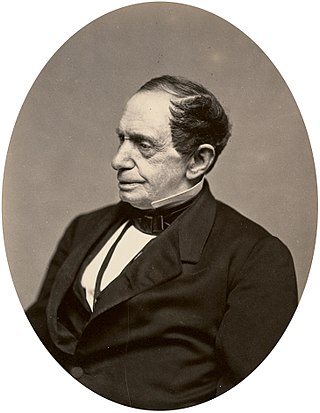
Johns Hopkins was an American merchant, investor, and philanthropist. Born on a plantation, he left his home to start a career at the age of 17, and settled in Baltimore, Maryland, where he remained for most of his life.
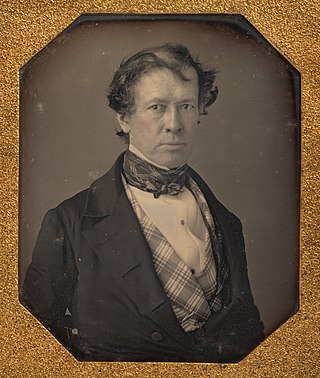
John Pendleton Kennedy was an American novelist, lawyer and Whig politician who served as United States Secretary of the Navy from July 26, 1852, to March 4, 1853, during the administration of President Millard Fillmore, and as a U.S. Representative from Maryland's 4th congressional district, during which he encouraged the United States government's study, adoption and implementation of the telegraph. A lawyer who became a lobbyist for and director of the Baltimore and Ohio Railroad, Kennedy also served several terms in the Maryland General Assembly, and became its Speaker in 1847.

Daniel Coit "D. C." Gilman was an American educator and academic. Gilman was instrumental in founding the Sheffield Scientific School at Yale College, and subsequently served as the second president of the University of California, Berkeley, as the first president of Johns Hopkins University, and as founding president of the Carnegie Institution.

George Peabody was an American financier and philanthropist. He is often considered the father of modern philanthropy.

The Peabody Institute of the Johns Hopkins University is a private music and dance conservatory and preparatory school in Baltimore, Maryland. Founded in 1857 and affiliated with Johns Hopkins in 1977, Peabody is the oldest conservatory in the United States and one of the world's most highly-regarded performing arts schools.

Enoch Pratt was an American businessman in Baltimore, Maryland. Pratt was also a committed active Unitarian, and a philanthropist. He is best known for his donations to establish the Enoch Pratt Free Library in Baltimore and expanding the former Sheppard Asylum to become The Sheppard and Enoch Pratt Hospital,, located north of the city in western Towson, county seat of Baltimore County. Born and raised in Massachusetts, he moved south to the Chesapeake Bay area and became devoted to the civic interests of the city of Baltimore. He earned his fortune as an owner of business interests beginning in the 1830s originally as a hardware wholesaler, and later expanding into railroads, banking and finance, iron works, and steamship lines and other transportation companies.

John Work Garrett was an American merchant turned banker who became president of the Baltimore and Ohio Railroad (B&O) in 1858 and led the railroad for nearly three decades. The B&O became one of the most important American railroads by the time Garrett died, and Garret would also become a noted philanthropist. He provided crucial support for the Union cause during the Civil War, expanded the railroad to reach Chicago, Illinois, and competed with the Pennsylvania Railroad for access to New York City.

Mount Vernon is a neighborhood of Baltimore, Maryland, located immediately north of the city's downtown. It is named for George Washington's Mount Vernon estate in Virginia, as the site of the city's Washington Monument.

The Washington Monument is the centerpiece of intersecting Mount Vernon Place and Washington Place, an urban square in the Mount Vernon-Belvedere neighborhood north of downtown Baltimore, Maryland. It was the first major monument to honor George Washington (1732–1799).
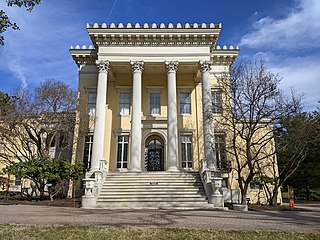
Evergreen Museum & Library is a historic house museum and research library in Baltimore, Maryland, United States. It is located between the campuses of the Notre Dame of Maryland University and Loyola University Maryland. It is operated by Johns Hopkins University along with Homewood Museum; both make up the Johns Hopkins University Museums.
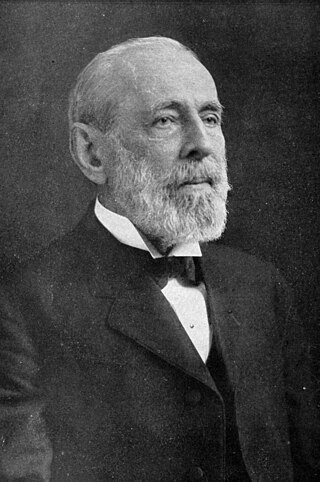
Philip Reese Uhler was an American librarian and entomologist who specialized in Hemiptera, an insect order commonly known as true bugs. He was considered America's foremost expert on this group and was widely sought out for identification of species in this order.
George Aloysius Frederick was a German-American architect with a practice in Baltimore, Maryland, where his most prominent commission was the Baltimore City Hall (1867–1875), awarded him when he was only age 21. Later in the late 19th century, he served as the semi-official municipal architect.

The Peabody Institute Library is the public library serving Peabody, Massachusetts. It was established in 1852 by a bequest from philanthropist and Peabody native George Peabody, and now has its main facility at 82 Main Street, with the South Branch at 78 Lynn Street and West Branch at 603 Lowell Street. The main library is housed in a two-story brick building built in 1853 which is now listed on the National Register of Historic Places. The library is claimed to be the oldest public library in the United States to operate continuously from the same location.

Edmund George Lind was an English-born American architect, active in Baltimore, Atlanta, and the American south.

The Homewood Campus is the main academic and administrative center of the Johns Hopkins University. It is located at 3400 North Charles Street in Baltimore, Maryland. It houses the two major undergraduate schools: the Zanvyl Krieger School of Arts and Sciences and the Whiting School of Engineering.

The "Henry Fite House", located on West Baltimore Street, between South Sharp and North Liberty Streets, later known as Hopkins Place, in Baltimore, Maryland, was the meeting site of the Second Continental Congress from December 20, 1776 until February 22, 1777.
The following is a timeline of the history of the city of Baltimore, Maryland, USA.
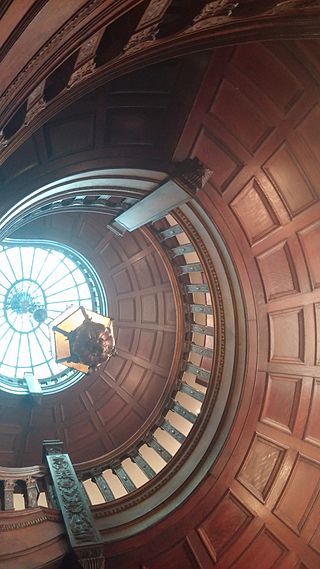
The Garrett Jacobs Mansion is a historic home located in the Mount Vernon neighborhood of Baltimore, Maryland. Built in 1853 by Samuel George, the home gets its name from its last and most famous owner, Mary Frick Garrett Jacobs, who, with her husband Robert Garrett, transformed the home into a prime example of the Gilded Age mansions of the city.
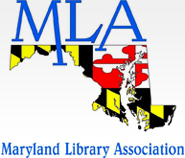
The Maryland Library Association (MLA) is a professional organization for Maryland's librarians and library workers. It is headquartered in Baltimore, Maryland. It was founded in November, 1923, in Baltimore, after a letter writing campaign by Charlotte Newell from the Maryland Public Library Advisory Commission. MLA's first president was Louis Dielman from the Peabody Institute. MLA was instrumental in supporting the creation of the graduate school of library science at the University of Maryland. The organization has been incorporated as a non-profit since 1974. The MLA's official newsletter is The CRAB. MLA has a reciprocal arrangement with DCLA whereby members can participate in each other's events and conferences at membership rates. In 1996, MLA established the Maryland Author Award to honor and promote local authors.


















